
Photo: FW Archive
A ccording to Prof Frikkie Neser of the Department of Animal, Wildlife and Grassland Sciences at the University of the Free State, the fundamentals for cattle and sheep farming are the same: you need a predetermined and fixed time frame for breeding.
Using this as a reference point, you can then develop a strategic feeding and health programme to complement it. However, you need to have control over where your bulls or rams are at any given time.
“Before you can play around with different breeding techniques, you first have to put a proper breeding season strategy in place,” he says.
In order to develop a breeding season strategy, you must first decide when mating will take place. As a general rule, the best time for this is a month before the rain starts. Also, heifers should be mated a month before cows, as they tend to take longer to recover.
Neser says it is good practice to mate your second-year heifers separately from the older cows, as the cows have a tendency to keep the bulls for themselves.
You should try to keep the mating season within a three-month period, says Neser, as
this enhances uniformity in all the later development stages. In summer rainfall areas, this means you should aim for a mating season that commences around 15 November for heifers, and 15 December for cows.
Breeding economics
If all goes well during the mating season, about 60% of calves are born within the first
30 days of the calving season. This is good, as it allows more time for the cows to recover, and calves will thus be heavier at weaning. The 60% rule is also a good check to see if there are any underlying issues that need attention.
It is important to pay close attention to the nutritional requirements of your animals throughout the year, but this is particularly crucial during mating and calving.
All farms differ in terms of rainfall, temperature, topography, veld composition and available food sources, but the problems for South African stock farmers generally occur in late winter when the nutritional value of natural veld is at its lowest.
You can address this by providing cattle with a protein lick together with strategic energy supplements. During hot summer months, a phosphate lick is a good addition to natural grazing.
It is also important to understand the implications of managing your breeding season to coincide with natural availability of grazing, or the absence thereof. Neser explains that if you schedule the breeding season in order to calve in spring, your herd will benefit from the availability of grazing throughout the coming summer months in summer rainfall areas.
A 2012 study conducted by Johan Mouton, manager of research and development for ruminants at RCL Foods, showed a 4,3% interest on capital for such a strategy on a beef cattle farm. In contrast to this, only a 2,7% interest on capital is realised if calving takes place in autumn.
Neser does not recommend winter calving for extensive livestock farming, but says that farmers may have a second calving season in winter for various reasons.
“Some farmers may implement a calving season during winter to give a cow a second chance if she did not take during the initial breeding season, or to take advantage of potentially higher weaner prices in summer.
“If you are planning to calve in winter, pay very close attention to the condition of your cows, and have additional food available to supplement their diet if their condition score drops to 2,5.
“A condition score must be allocated to each animal on the basis of its fat and muscle covering, with a score awarded on a scale from 1 to 5, where 1 is very thin, and 5 is overweight. Also, according to the work done by Mouton, the weaner prices [in summer] need to be at least 26% higher in order for this strategy to make financial sense,” says Neser.
The condition of animals going into the breeding season is very important. Heifers should be at 60% to 65% of their mature weight at the start of the breeding season, and cows should have a condition score of 3,5 at the start of the breeding season.
“At a score of 3,5, a cow is not too lean and not too fat,” he says.
Benefits of a planned breeding season
“If stock farmers manage the breeding season properly, there are several management and financial advantages to unlock,” says Neser.
First, animal health is easier to manage through inoculation and disease-control programmes. In-calf animals often need different treatments compared with open animals, and different development stages require different health, strategic supplementary feeding, and lick programmes.
If the breeding season has been synchronised into a short time frame, the herd will be more uniform, allowing for more effective treatments. It also makes it possible to consider more options to address issues that might arise.
Second, a defined breeding season will result in a larger, more uniform group of calves. This enhances the options and ability to negotiate better prices when marketing the animals.
At the same time, you will have a larger group of open culled cows to market. This can improve your cash flow.
Taking care of bulls
Bull management is fundamental to a successful breeding season strategy. Neser says that a common mistake farmers make is to buy bulls in and then put them to work immediately.
“You need to remember that transport and adapting to a new location is stressful and might result in a loss of fertility for the bull,” says Neser.
Spermatogenesis takes about six weeks, so allow your new bull to be on the farm for at least two months before the breeding season starts. It is also important that bulls bought at auctions or from stud farms be exercised regularly to ensure they are fit. In order to get the most from a bull, it needs to be in top physical condition. This means a condition score of 3,5 to 4 at the start of the breeding season.
If you have planned for the breeding season, you can manage the bull’s diet and exercise regime to coincide with this. It is important to test a bull’s fertility before, and in the middle of, the breeding season, says Neser. You should also test and inoculate your bull for venereal diseases as part of your health strategy.
“Having a top bull and watching it mount cows from a distance is not good enough,” he cautions.
You need to be certain that the bull can mount and penetrate the cow’s vulva successfully.
“It has happened that a farmer might discover a bull has a damaged or broken penis when it is too late because of a failure to pay close attention during the breeding season.”
You also have to monitor the breeding herd regularly in order to identify lazy bulls. You should also watch out for bulls that show drastic weight loss during the breeding season, as they need to be replaced or treated for health issues, he adds.
Speeding up herd improvement
In order to get the best results, conduct pregnancy tests two to three months after the bulls are removed from the herd.
“I recommend that heifers [that didn’t conceive] be culled immediately, as there is no good reason for them to not be in calf. With open cows, you need to consider that they will only give you returns in another 15 months’ time, so if you decide to keep them, be sure your reasoning is based on sound logic and their history,” says Neser.
A well-managed breeding season also holds the potential for the farmer to improve the genetics of a herd. Because calves are born in a defined period of time, they are of a uniform age. There are fewer corrections to make, and more accurate breeding values can thus be obtained.
It also means that you can now be more specific when selecting for fertility as you can obtain days-to-calving breeding values, and it is much easier to manage the age at which maiden heifers are mated.
These factors assist you in determining which cows are less fertile, and which ones are strategic to a longer-term breeding strategy.
Email Prof Frikkie Neser at [email protected].













